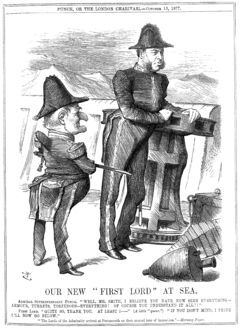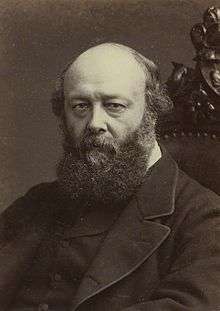William Henry Smith (1825–1891)
| The Right Honourable William Henry Smith | |
|---|---|
.jpg) | |
| First Lord of the Treasury | |
|
In office 14 January 1887 – 6 October 1891 | |
| Monarch | Victoria |
| Prime Minister | The Marquess of Salisbury |
| Preceded by | The Marquess of Salisbury |
| Succeeded by | Arthur Balfour |
| Leader of the House of Commons | |
|
In office 14 January 1887 – 6 October 1891 | |
| Monarch | Victoria |
| Prime Minister | The Marquess of Salisbury |
| Preceded by | Lord Randolph Churchill |
| Succeeded by | Arthur Balfour |
| Personal details | |
| Born |
24 June 1825 London, England |
| Died | 6 October 1891 (aged 66) |
| Nationality | British |
| Political party | Conservative |
| Spouse(s) |
Emily Danvers (1828–1913) |
| Alma mater | None |
William Henry Smith PC (24 June 1825 – 6 October 1891) was an English bookseller and newsagent of the family firm W H Smith, who expanded the firm and introduced the practice of selling books and newspapers at railway stations. He was elected a Member of Parliament in 1868 and rose to the position of First Lord of the Admiralty less than ten years thereafter. Because of his lack of naval experience, he was perceived as a model for the character Sir Joseph Porter in H.M.S. Pinafore. In the mid-1880s, he was twice Secretary of State for War, and later First Lord of the Treasury and Leader of the House of Commons, among other posts.
Background and business career
Smith was born in London, the son of William Henry Smith (1792–1865). He was educated at Tavistock Grammar School before joining the business with his father in 1846, at which time the firm became W H Smith & Son.[1] Smith and his father took advantage of the railway boom by opening newsstands on railway stations, starting with Euston in 1848.[1] In 1850 the firm opened depots in Birmingham, Manchester and Liverpool. The business became a household name (W H Smith), and Smith used the success of the firm as a springboard into politics.[1][2]
He was elected in February 1878 a Fellow of the Royal Society.[3]
Political career

_and_Robert_Gascoyne-Cecil%2C_3rd_Marquess_of_Salisbury_-_Cartoon_from_Punch_-_1891_-_Project_Gutenberg_eText_14808.png)
W. H. Smith: "Hooray – another stroke or two and we've done it."
Cartoon satirising Smith as rowing and Lord Salisbury, Prime Minister, swimming towards the end of the Parliamentary year to escape the twin waves of Free Education and Land Purchase, contentious issues of the time. Smith died three months after the publication of this cartoon.
From Punch, 1891
In 1868, Smith was elected Member of Parliament for Westminster as a Conservative after an initial attempt to get into Parliament as a "Liberal Conservative" in 1865 as a supporter of Palmerston. In 1874 Smith was appointed Financial Secretary to the Treasury when Disraeli returned as Prime Minister. In 1877 he became First Lord of the Admiralty. It has been claimed that Smith's appointment was the inspiration for the character of Sir Joseph Porter, KCB, in Gilbert and Sullivan's 1878 comic opera, H. M. S. Pinafore. Gilbert had written to Sullivan in December 1877 "The fact that the First Lord in the opera is a Radical of the most pronounced type will do away with any suspicion that W. H. Smith is intended." However, the character was seen as a reflection on Smith and even Disraeli was overheard to refer to his First Lord as "Pinafore Smith".[4][5] It has been suggested that the Pinafore character was as much based on Smith's controversial predecessor as First Lord, Hugh Childers, as on Smith himself.[6] Smith held this office for three years until the Liberals returned to power.
In 1885 a redistribution of seats led to Smith now standing for the Strand division in Westminster, and he served as Chief Secretary for Ireland for a short period in the following year. He was twice Secretary of State for War, the first time during Lord Salisbury's brief ministry between 1885 and 1886, and the second when the Conservatives won the 1886 General Election. He succeeded this appointment in 1887 as First Lord of the Treasury and Leader of the House of Commons, and became Lord Warden of the Cinque Ports in 1891.
He died shortly afterwards at Walmer Castle, and his widow was created Viscountess Hambleden in his honour, taking the title from the village close to the Smiths' country house of Greenlands, near Henley-on-Thames. One of the few ministers personally close to Lord Salisbury (apart from the latter's nephew, Arthur Balfour), Smith was dubbed "Old Morality" due to his austere manner and conduct.
Family

Smith married Emily, daughter of Frederick Dawes Danvers, in 1858. They had two sons and four daughters: Mabel Danvers Smith (d. 1956; she married the 5th Earl of Harrowby), Emily Anna Smith (1859–1942; she married Admiral William Acland), Helen Smith (1860–1944), Beatrice Danvers Smith (1864–1942), Henry Walton Smith (1865–1866) and William Frederick Danvers Smith (1868–1928). He died in October 1891, aged 66.[7] The following month his widow was raised to the peerage in his honour as Viscountess Hambleden, of Hambleden in the County of Buckingham. She died in August 1913 and was succeeded by her and Smith's only surviving son, Frederick.
Endnotes
- 1 2 3 "The First WH Smith Railway Bookstall - Research and Read Books, Journals, Articles at Questia Online Library". Questia.com. Retrieved 2010-08-20.
- ↑ History of WH Smith, W H Smith plc, accessed 10 October 2012
- ↑ "Library and Archive Catalogue". Royal Society. Retrieved 19 October 2010.
- ↑ H.M.S. Pinafore in Full Score. p. v.
- ↑ Jacobs, Arthur (1986). Arthur Sullivan – A Victorian Musician. Oxford University Press. p. 115. ISBN 0-19-282033-8.
- ↑ Carr, rev Matthew. Childers, Hugh. Oxford Dictionary of National Biography.
- ↑ Lundy, Darryl. "William Henry Smith", The Peerage, p. 2112, accessed 10 October 2012
Bibliography

| Wikimedia Commons has media related to William Henry Smith (politician). |
- Gilbert, W. S.; Sullivan, Sir Arthur (2002). Jones, Ephraim Hammett; Simpson, Carl, eds. H.M.S. Pinafore in Full Score (New ed.). Mineola, New York: Dover Publications, Inc. ISBN 0-486-42201-1.
- Maxwell, Sir Herbert, Bart., M.P. (1894). Life of the Right Honourable William Henry Smith M.P. (New ed.). London: William Blackwood and Sons.
Further reading
- Maxwell, Herbert Eustace (1898). "Smith, William Henry (1825–1891)". In Lee, Sidney. Dictionary of National Biography. 53. London: Smith, Elder & Co.
- Anonymous (1873). Cartoon portraits and biographical sketches of men of the day. Illustrated by Frederick Waddy. London: Tinsley Brothers. pp. 112–113. Retrieved 13 March 2011.
External links
- Hansard 1803–2005: contributions in Parliament by W. H. Smith
.svg.png)
